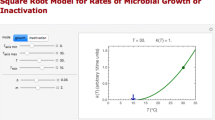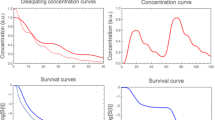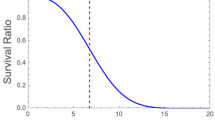Abstract
A dynamic (e.g., non-isothermal) kinetic model of microbial survival during a lethal process or growth under favorable conditions is either in the form of a differential rate equation from the start or obtained from an algebraic static model by derivation. Examples of the first kind are the original and modified versions of the logistic (Verhulst) equation and of the second the dynamic Weibull survival or Gompertz growth models. In the first-order inactivation kinetics, the isothermal logarithmic survival rate is a function of temperature only. Therefore, converting its static algebraic form into a dynamic differential rate equation, or vice versa, is straightforward. There is also no issue where both the static and dynamic versions of the survival or growth model are already in the form of a differential rate equation as in the logistic equation of growth. In contrast, converting the nonlinear static algebraic Weibull survival model or the Gompertz growth model into a dynamic differential rate equation, requires replacement of the nominal time t by t*, defined as the time which corresponds to the momentary static survival or growth ratio at the momentary temperature. This replacement of the nominal time in the rate equation with a term that contains the momentary survival or growth ratio eliminates inevitable inconsistencies and renders the resulting dynamic model truly predictive. The concept is demonstrated with simulated dynamic microbial survival patterns during a hypothetical thermal sterilization where the temperature fluctuates and with simulated dynamic microbial growth in storage where the temperature oscillates.











Similar content being viewed by others
Availability of Data and Materials
Not applicable.
References
Horowitz J, Normand MD, Corradini MG, Peleg M (2010) A probabilistic model of growth, division, and mortality of microbial cells. Appl Environ Microbiol 76:230–242
Peleg M, Penchina CM (2000) Modeling microbial survival during exposure to a lethal agent with varying intensity. Crit Rev Food Sci 40:159–172
Corradini MG, Peleg M (2004) Demonstration of the Weibull-Log logistic survival model’s applicability to non-isothermal inactivation of E. coli K12 MG1655. J Food Protect 67:2617–2621
Valdramidis VP, Geeraerd AH, Bernaerts K, Van Impe JF (2006) Microbialdynamics versus mathematical model dynamics: the case of microbial heat resistance induction. Innov Food Sci Emer Technol 7:80–87
Simpson-Smith S, Corradini MG, Normand MD, Peleg M, Schaffner DW (2007) Estimating microbial growth parameters from non-isothermal data: a case study with Clostridium perfringens. Intnl J Food Microbiol 118:294–303
Peleg M (2019) Expanded discrete and continuous Bĕlehrádek/Ratkowski models of microbial growth rates under oscillating and extreme storage temperatures. Food Eng Rev 11:219–234
Peleg M (2003) Microbial survival curves: interpretation, mathematical modeling, and utilization. Comm Theor Biol 8:357–387
Gil MM, Miller FA, Brabdao RS, Silva CLM (2011) On the use of the Gompertz model to predict microbial thermal inactivation under isothermal and non-isothermal conditions. Food Eng Rev 3:17–25
Zwiterinng MH, Longenbuger I, Rombouts FM, van’t Riet K (1990) Modeling bacterial growth curve. Appl Environ Microbiol 56:1875–1881
Lopez S, Prieto M, Dijksra J, Dhanoa MS, France J (2004) Statistical evaluation of mathematical models for microbial growth. Intnl J Food Microbiol 96:289–300
Perni S, Andrew PW, Shama G (2005) Estimating the maximum growth rate from microbial growth curves: definition is everything. Food Microbiol 22:491–495
Peleg M, Corradini MG (2011) Microbial growth models - what do they tell us and what do they not. Crit Rev Food Sci Nut 51:91–945
Grasso AL, Fort A, Mahdizadeh FF, Magnani A, Mocceni C (2023) Generalized logistic model of bacterial growth. Math Comp Model Dynam Systms 29:169–185
Peleg M, Corradini MG, Normand MD (2007) The logistic (Verhulst) model for sigmoid microbial growth curves revisited. Food Res Intnl 40:808–818
Tjørve KMC, Tjørve E (2017) The use of Gompertz models in growth analyses, and new Gompertz-model approach: an addition to the Unified-Richards family. PLoS ONE 12(6):e0178691. https://doi.org/10.1371/journal.pone.0178691
Shinohara MKS, Freitas F, Pires EF, Andrade AC, Lima Fiho JL, Sousa HM (2018) Statistical evaluation of mathematical models for Salmonella typhimurium growth. Rev Geama Recife 4:33–38
Corradini MG, Peleg M (2006) Prediction of vitamins loss during non-isothermal heat processes and storage with nonlinear kinetic models. Trends Food Sci Technol 17:24–24
Peleg M (2016) A kinetic model and endpoints method for volatiles formation in stored fresh fish. Food Res Intnl 86:156–161
Acknowledgements
This review has been written in honor of the late Professor of Physics Claude M. Penchina who introduced the notion of t* to modeling dynamic microbial inactivation. The author expresses his thanks to Mark D. Normand for his technical help in programing.
Author information
Authors and Affiliations
Contributions
I am the sole author, conceived the idea, produced the figures, and wrote the manuscript.
Corresponding author
Ethics declarations
Ethics Approval
Not applicable.
Conflict of Interest
The author declares no competing interests.
Additional information
Publisher's Note
Springer Nature remains neutral with regard to jurisdictional claims in published maps and institutional affiliations.
Rights and permissions
Springer Nature or its licensor (e.g. a society or other partner) holds exclusive rights to this article under a publishing agreement with the author(s) or other rightsholder(s); author self-archiving of the accepted manuscript version of this article is solely governed by the terms of such publishing agreement and applicable law.
About this article
Cite this article
Peleg, M. On the Time Presentation in Differential Rate Equations of Dynamic Microbial Inactivation and Growth. Food Eng Rev 16, 179–191 (2024). https://doi.org/10.1007/s12393-023-09365-z
Received:
Accepted:
Published:
Issue Date:
DOI: https://doi.org/10.1007/s12393-023-09365-z




